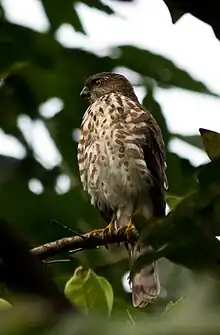| Besra | |
|---|---|
 | |
| Besra Sparrowhawk at Waththegama, Sri Lanka | |
| Scientific classification | |
| Domain: | Eukaryota |
| Kingdom: | Animalia |
| Phylum: | Chordata |
| Class: | Aves |
| Order: | Accipitriformes |
| Family: | Accipitridae |
| Genus: | Accipiter |
| Species: | A. virgatus |
| Binomial name | |
| Accipiter virgatus (Temminck, 1822) | |
 | |
| Global range Year-Round Range Summer Range Winter Range | |
The besra (Accipiter virgatus), also called the besra sparrowhawk, is a bird of prey in the family Accipitridae.
The besra is a widespread resident breeder in dense forests throughout southern Asia, ranging from the Indian subcontinent eastwards across Southeast Asia and into East Asia. It nests in trees, building a new nest each year. It lays 2 to 5 eggs.
This bird is a medium-sized raptor (29 to 36 cm) with short broad wings and a long tail, both adaptations to fast maneuvering through dense vegetation. The normal flight of this species is a characteristic "flap–flap–glide".
This species is like a darker version of the widespread shikra with darker upperparts, strongly barred underwing, broader gular stripe and thin long legs and toes. The adult male besra has dark blue-grey upperparts, and is white, barred reddish brown below. The larger female is browner above than the male. The juvenile is dark brown above and white, barred with brown below. In all plumages have 3-4 equally sized dark bands on uppertail.
In winter, the besra will emerge into more open woodland including savannah and cultivation. Its hunting technique is similar to other small hawks such as the sparrowhawk and the sharp-shinned hawk, relying on surprise as it flies from a hidden perch or flicks over a bush to catch its prey unaware.
The prey is lizards, dragonflies, and small birds and mammals.


Taxonomy
Ten subspecies are recognised:[2]
- A. v. affinis Hodgson, 1836 – west Himalayas to central China and Indochina
- A. v. fuscipectus Mees, 1970 – Taiwan
- A. v. besra Jerdon, 1839 – south India and Sri Lanka
- A. v. vanbemmeli Voous, 1950 – montane Sumatra
- A. v. rufotibialis Sharpe, 1887 – montane Borneo
- A. v. virgatus (Temminck, 1822) – montane Java and Bali
- A. v. quinquefasciatus Mees, 1984 – montane Flores (central Lesser Sunda Islands)
- A. v. abdulalii Mees, 1981 – Andaman and Nicobar Islands
- A. v. confusus Hartert, EJO, 1910 – north, central Philippines
- A. v. quagga Parkes, 1973 – central, south Philippines (except Palawan group and Sulu Archipelago)
References
- ↑ BirdLife International (2016). "Accipiter virgatus". IUCN Red List of Threatened Species. 2016: e.T22695588A93517794. doi:10.2305/IUCN.UK.2016-3.RLTS.T22695588A93517794.en. Retrieved 11 November 2021.
- ↑ Gill, Frank; Donsker, David; Rasmussen, Pamela, eds. (July 2023). "Hoatzin, New World vultures, Secretarybird, raptors". IOC World Bird List Version 13.2. International Ornithologists' Union. Retrieved 25 October 2023.
- Birds of India by Grimmett, Inskipp and Inskipp, ISBN 0-691-04910-6
